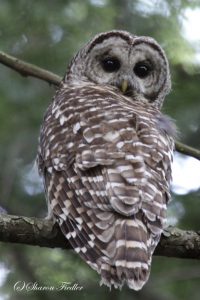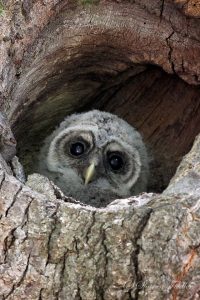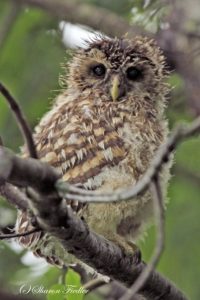February 23, 2017 at 1:03 pm
By Wildlife Biologist Erynn Call
 Have you ever thrown an apple core out the car window and thought it was a harmless action, or maybe even a nice snack for a little critter? Tossing out edible tidbits while driving can threaten wildlife, particularly raptors such as hawks and owls. These birds are attracted to roadways as they provide convenient perches on power lines with clear views of their prey. Vegetation is cut short and in winter roadsides make for easy hunting grounds as there is less snow. If the surrounding landscape is covered in ice, capturing prey is challenging as rodents scamper underneath an impenetrable crusty layer. Roads then become an even more appealing dining locale.
Adding food scraps increases the number of rodents and the chance of crossing paths with a car while swooping across the roadway. Because this roadside hunting approach is easier than dodging through a field or forest after a meal, younger, inexperienced birds are often more susceptible to vehicle collisions. One raptor that seems to be in this predicament often is the Barred Owl. Avian Haven, a bird rehabilitator located in Freedom Maine, admitted 80 Barred Owls in 2015!
If you are fortunate enough to see a mid-sized (20 inch) owl, you can bet it’s this one. The Barred Owl is one of Maine’s most common owl species. Their
Have you ever thrown an apple core out the car window and thought it was a harmless action, or maybe even a nice snack for a little critter? Tossing out edible tidbits while driving can threaten wildlife, particularly raptors such as hawks and owls. These birds are attracted to roadways as they provide convenient perches on power lines with clear views of their prey. Vegetation is cut short and in winter roadsides make for easy hunting grounds as there is less snow. If the surrounding landscape is covered in ice, capturing prey is challenging as rodents scamper underneath an impenetrable crusty layer. Roads then become an even more appealing dining locale.
Adding food scraps increases the number of rodents and the chance of crossing paths with a car while swooping across the roadway. Because this roadside hunting approach is easier than dodging through a field or forest after a meal, younger, inexperienced birds are often more susceptible to vehicle collisions. One raptor that seems to be in this predicament often is the Barred Owl. Avian Haven, a bird rehabilitator located in Freedom Maine, admitted 80 Barred Owls in 2015!
If you are fortunate enough to see a mid-sized (20 inch) owl, you can bet it’s this one. The Barred Owl is one of Maine’s most common owl species. Their  distinguishing features include dark brown eyes, brown and white striped feathers, and lack of ear tufts (Great Horned Owls have these). Their hooting call sounds like “Who cooks for you? Who cooks for you all?” Pairs mate for life and during courtship the male and female call together. They do not migrate and often reuse nests of other raptors, crows, and squirrels. Cavities created by Pileated Woodpeckers make ideal locations for a Barred Owl nest.
In Maine, courtship begins in February, two to four eggs are laid in April and hatch about a month later. After some initial exploration on nearby branches the young owls are ready five weeks after hatching to fledge or fly from the nest. They are still cared for by the parents and tend to hang out in the parents territory while learning to hunt. In total, parents care for the owlets for at least four months. When the young are ready to be independent and settle into their own territory they don’t travel too far from their parents, typically less than six miles away. The lifespan of a Barred Owl may be ten years or more, and they have been documented living up to 32 years in captivity.
distinguishing features include dark brown eyes, brown and white striped feathers, and lack of ear tufts (Great Horned Owls have these). Their hooting call sounds like “Who cooks for you? Who cooks for you all?” Pairs mate for life and during courtship the male and female call together. They do not migrate and often reuse nests of other raptors, crows, and squirrels. Cavities created by Pileated Woodpeckers make ideal locations for a Barred Owl nest.
In Maine, courtship begins in February, two to four eggs are laid in April and hatch about a month later. After some initial exploration on nearby branches the young owls are ready five weeks after hatching to fledge or fly from the nest. They are still cared for by the parents and tend to hang out in the parents territory while learning to hunt. In total, parents care for the owlets for at least four months. When the young are ready to be independent and settle into their own territory they don’t travel too far from their parents, typically less than six miles away. The lifespan of a Barred Owl may be ten years or more, and they have been documented living up to 32 years in captivity.
 Barred Owls typically hunt at dawn, dusk, or at night but will also search for food during the day. Forests in spring, summer, and fall and provide a variety of delectable meals such as chipmunks, mice, voles, salamanders, frogs, and invertebrates. A fish in shallow water might even need to watch out for an adventurous wading Barred Owl. In winter, while some of these creatures are inaccessible, Barred Owls switch their diet to rodents and hone in on roadside hunting. This menu is dangerous as collisions with passing vehicles are much more likely.
The number of owls you see can change annually based upon natural fluctuations in population abundances. This rise and fall is related to complex factors such as interactions between weather patterns, seed production, and rodent populations. Barred Owls are plentiful and doing well, and according to the North American Breeding Bird Survey their populations increased 1.5% between 1966 and 2014. While they are a very common species, and populations are not in danger, your actions can directly benefit these beautiful birds!
What you can do to help Barred Owls and all birds of prey, on the roadways and beyond:
Barred Owls typically hunt at dawn, dusk, or at night but will also search for food during the day. Forests in spring, summer, and fall and provide a variety of delectable meals such as chipmunks, mice, voles, salamanders, frogs, and invertebrates. A fish in shallow water might even need to watch out for an adventurous wading Barred Owl. In winter, while some of these creatures are inaccessible, Barred Owls switch their diet to rodents and hone in on roadside hunting. This menu is dangerous as collisions with passing vehicles are much more likely.
The number of owls you see can change annually based upon natural fluctuations in population abundances. This rise and fall is related to complex factors such as interactions between weather patterns, seed production, and rodent populations. Barred Owls are plentiful and doing well, and according to the North American Breeding Bird Survey their populations increased 1.5% between 1966 and 2014. While they are a very common species, and populations are not in danger, your actions can directly benefit these beautiful birds!
What you can do to help Barred Owls and all birds of prey, on the roadways and beyond:
 Have you ever thrown an apple core out the car window and thought it was a harmless action, or maybe even a nice snack for a little critter? Tossing out edible tidbits while driving can threaten wildlife, particularly raptors such as hawks and owls. These birds are attracted to roadways as they provide convenient perches on power lines with clear views of their prey. Vegetation is cut short and in winter roadsides make for easy hunting grounds as there is less snow. If the surrounding landscape is covered in ice, capturing prey is challenging as rodents scamper underneath an impenetrable crusty layer. Roads then become an even more appealing dining locale.
Adding food scraps increases the number of rodents and the chance of crossing paths with a car while swooping across the roadway. Because this roadside hunting approach is easier than dodging through a field or forest after a meal, younger, inexperienced birds are often more susceptible to vehicle collisions. One raptor that seems to be in this predicament often is the Barred Owl. Avian Haven, a bird rehabilitator located in Freedom Maine, admitted 80 Barred Owls in 2015!
If you are fortunate enough to see a mid-sized (20 inch) owl, you can bet it’s this one. The Barred Owl is one of Maine’s most common owl species. Their
Have you ever thrown an apple core out the car window and thought it was a harmless action, or maybe even a nice snack for a little critter? Tossing out edible tidbits while driving can threaten wildlife, particularly raptors such as hawks and owls. These birds are attracted to roadways as they provide convenient perches on power lines with clear views of their prey. Vegetation is cut short and in winter roadsides make for easy hunting grounds as there is less snow. If the surrounding landscape is covered in ice, capturing prey is challenging as rodents scamper underneath an impenetrable crusty layer. Roads then become an even more appealing dining locale.
Adding food scraps increases the number of rodents and the chance of crossing paths with a car while swooping across the roadway. Because this roadside hunting approach is easier than dodging through a field or forest after a meal, younger, inexperienced birds are often more susceptible to vehicle collisions. One raptor that seems to be in this predicament often is the Barred Owl. Avian Haven, a bird rehabilitator located in Freedom Maine, admitted 80 Barred Owls in 2015!
If you are fortunate enough to see a mid-sized (20 inch) owl, you can bet it’s this one. The Barred Owl is one of Maine’s most common owl species. Their  distinguishing features include dark brown eyes, brown and white striped feathers, and lack of ear tufts (Great Horned Owls have these). Their hooting call sounds like “Who cooks for you? Who cooks for you all?” Pairs mate for life and during courtship the male and female call together. They do not migrate and often reuse nests of other raptors, crows, and squirrels. Cavities created by Pileated Woodpeckers make ideal locations for a Barred Owl nest.
In Maine, courtship begins in February, two to four eggs are laid in April and hatch about a month later. After some initial exploration on nearby branches the young owls are ready five weeks after hatching to fledge or fly from the nest. They are still cared for by the parents and tend to hang out in the parents territory while learning to hunt. In total, parents care for the owlets for at least four months. When the young are ready to be independent and settle into their own territory they don’t travel too far from their parents, typically less than six miles away. The lifespan of a Barred Owl may be ten years or more, and they have been documented living up to 32 years in captivity.
distinguishing features include dark brown eyes, brown and white striped feathers, and lack of ear tufts (Great Horned Owls have these). Their hooting call sounds like “Who cooks for you? Who cooks for you all?” Pairs mate for life and during courtship the male and female call together. They do not migrate and often reuse nests of other raptors, crows, and squirrels. Cavities created by Pileated Woodpeckers make ideal locations for a Barred Owl nest.
In Maine, courtship begins in February, two to four eggs are laid in April and hatch about a month later. After some initial exploration on nearby branches the young owls are ready five weeks after hatching to fledge or fly from the nest. They are still cared for by the parents and tend to hang out in the parents territory while learning to hunt. In total, parents care for the owlets for at least four months. When the young are ready to be independent and settle into their own territory they don’t travel too far from their parents, typically less than six miles away. The lifespan of a Barred Owl may be ten years or more, and they have been documented living up to 32 years in captivity.
 Barred Owls typically hunt at dawn, dusk, or at night but will also search for food during the day. Forests in spring, summer, and fall and provide a variety of delectable meals such as chipmunks, mice, voles, salamanders, frogs, and invertebrates. A fish in shallow water might even need to watch out for an adventurous wading Barred Owl. In winter, while some of these creatures are inaccessible, Barred Owls switch their diet to rodents and hone in on roadside hunting. This menu is dangerous as collisions with passing vehicles are much more likely.
The number of owls you see can change annually based upon natural fluctuations in population abundances. This rise and fall is related to complex factors such as interactions between weather patterns, seed production, and rodent populations. Barred Owls are plentiful and doing well, and according to the North American Breeding Bird Survey their populations increased 1.5% between 1966 and 2014. While they are a very common species, and populations are not in danger, your actions can directly benefit these beautiful birds!
What you can do to help Barred Owls and all birds of prey, on the roadways and beyond:
Barred Owls typically hunt at dawn, dusk, or at night but will also search for food during the day. Forests in spring, summer, and fall and provide a variety of delectable meals such as chipmunks, mice, voles, salamanders, frogs, and invertebrates. A fish in shallow water might even need to watch out for an adventurous wading Barred Owl. In winter, while some of these creatures are inaccessible, Barred Owls switch their diet to rodents and hone in on roadside hunting. This menu is dangerous as collisions with passing vehicles are much more likely.
The number of owls you see can change annually based upon natural fluctuations in population abundances. This rise and fall is related to complex factors such as interactions between weather patterns, seed production, and rodent populations. Barred Owls are plentiful and doing well, and according to the North American Breeding Bird Survey their populations increased 1.5% between 1966 and 2014. While they are a very common species, and populations are not in danger, your actions can directly benefit these beautiful birds!
What you can do to help Barred Owls and all birds of prey, on the roadways and beyond:
- Avoid throwing food out your car window.
- Be an alert driver and keep a keen eye on your surroundings.
- Keep your distance if you see an owl. It’s always best to avoid disturbing any wildlife – a quick photo could mean the animal has to expend valuable energy distancing itself or missing a chance at a meal.
- Avoid using rat poison - many raptors, including owls are killed by consuming poisoned rodents. Learn more by visiting raptorsarethesolution.org
- Learn more about Barred Owls and other birds of prey by visiting the MDIFW web page or allaboutbirds.org.
Categories